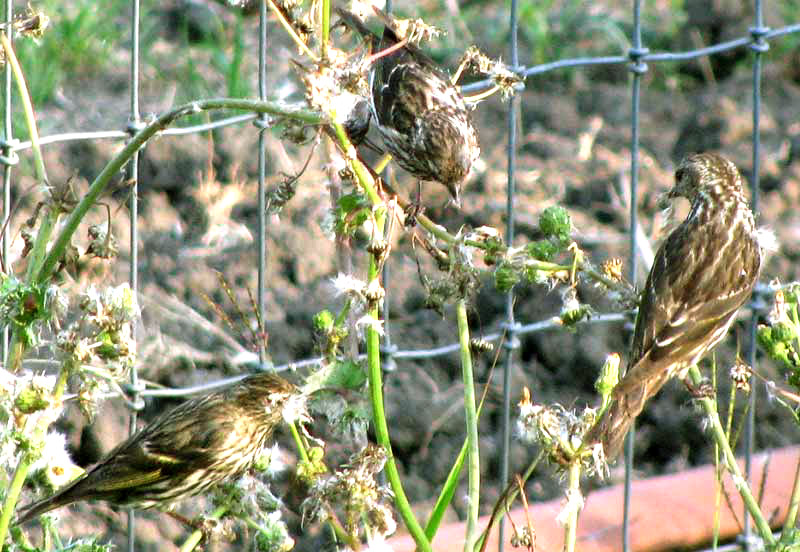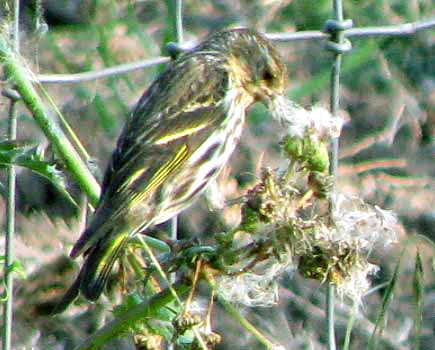Excerpts from Jim Conrad's
Naturalist Newsletter

from the the May 5, 2013 Newsletter issued from the Frio Canyon Nature Education Center in northern Uvalde County, southwestern Texas, on the southern border of the Edwards Plateau; elevation ~1750m (~5750 ft); N29.62°, W99.86°; USA
PINE SISKINS IN THE SOW THISTLES
Again the scrappy looking but benevolent sow thistles outside my kitchen window have hosted birds worth looking at. This time they were plain-looking birds but with an interesting story. Above you can see three of a flock of maybe a dozen.
At first glance, with the brown color and heavily streaked chests, I thought they were female and immature House Finches. However, then I noticed that the bills were too thin for finch bills. Also, sometimes a bird would perch just right so that a hint of yellow would show along a wing's bottom edge, as shown on one tugging at sow-thistle fuzz below:

The little streak of yellow, the deeply notched tail, and slender beak on a bird that otherwise looks like a House Finch all are good field marks for the Pine Siskin, SPINUS PINUS, which I was a little surprised to see here.
Back in the 60s in Kentucky I never saw them.My 1966 Robbins Birds of North America shows them completely absent from the US Southeast, except for the Appalachians. During the summer they nest in coniferous or mixed coniferous and deciduous forests with open canopies in Canada and mountainous western US, but during the winter nowadays they range all through forested North America searching for seeds, even entering weedy fields, scrubby thickets, and backyards, like they're doing here.
The migration pattern of Pine Siskins is described as "eruptive" -- some years you hardly see them, but in other years many turn up. In Eastern North America the general pattern is that of eruptions occurring every other year.
Pine Siskins do crave the hard little fruits produced on sow thistles. Sow thistle fruits are like those of the dandelion -- finger-shaped beneath a white-fuzz parachute that helps the fruit disseminate on the wind -- but smaller. Like dandelions, sow thistle plants are full of white, sticky, milk-like latex. As the birds poke into the plants' fruiting heads, latex sticks to their beaks and white fuzz sticks to the latex, causing many birds to fly away looking like they have white beards. The birds perch on a fence wiping their beaks back and forth across the wires, but that latex is powerful stuff and the fuzz is hard to get off. Sometimes the birds get so frustrated that they try to scratch with their feet and wipe on a wire at the same time, and almost tumble off.
It seems that every species has its handful of aggravations that we other species know very little about.